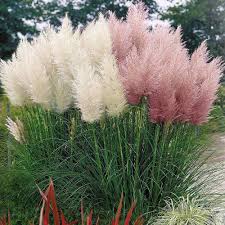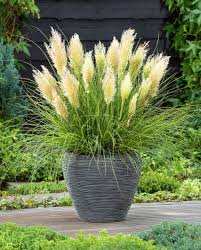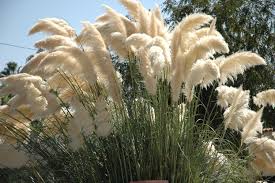Cortaderia Grass is a type of grass that grows in many gardens and yards around the world. Its scientific name is Cortaderia selloana, but some people also call it Pampas Grass. This grass comes from South America and has a special look that many people like.
Cortaderia Grass is tall. Sometimes, it can grow to be as tall as a basketball hoop, or even taller. It has special fluffy parts on top, which can be different colors like white, pink, or purple. These fluffy parts are called plumes. When the wind blows, the plumes move around, and it looks very pretty.
People like to grow Cortaderia Grass in their gardens because it’s not too hard to take care of. It needs a lot of sunlight and soil that lets water go through it easily. When you plant it, you need to leave some space between each plant because it can spread out a lot. At first, you need to give it water often, but when it gets older, it can handle not getting watered as much.
People use Cortaderia Grass to make their gardens look nice. They can put it in the back of the garden to make everything else in front of it look better. Some people also use the fluffy parts to make decorations inside their houses.
However, we need to be careful with Cortaderia Grass in some places. In some areas, it can grow too much and not let other plants grow. This is not good for the environment. So, before you plant Cortaderia Grass, you should ask the people who know about plants if it’s okay to grow it where you live.
In addition, Cortaderia Grass is a special kind of grass that makes gardens and yards look beautiful. It’s easy to grow and has fluffy parts that move with the wind. Just remember, in some places, it can cause problems if it grows too much, so it’s important to be careful and ask for advice before planting it.
Read Also: 15 Medicinal Health Benefits of Alocasia cucullata (Chinese taro)
How to Grow and Care for Cortaderia Grass

Growing and caring for Cortaderia Grass is a rewarding endeavor that can add beauty and texture to your outdoor space. Here’s a simple guide to help you get started:
Planting
1. Choose the Right Location: Cortaderia Grass loves sunlight, so pick a spot in your garden that receives full sun for most of the day. Make sure the soil is well-draining to prevent waterlogging.
2. Prepare the Soil: Loosen the soil in the planting area using a garden fork or shovel. You can add compost or well-rotted manure to improve the soil’s fertility and drainage.
3. Planting Depth: Dig a hole that’s about twice the size of the root ball of the plant. Place the plant in the hole, making sure it’s at the same depth it was in the container.
4. Spacing: Cortaderia Grass can spread, so make sure to space the plants at least 6 to 8 feet apart to allow them room to grow.
5. Watering: After planting, water the grass thoroughly to help it settle into the soil. Water regularly during the first few weeks until the grass establishes its root system.
Care

1. Watering: While Cortaderia Grass is drought-tolerant once established, it’s important to water it regularly during its first growing season. After that, water it during dry periods to keep it healthy.
2. Fertilizing: Fertilize Cortaderia Grass in the spring with a balanced, slow-release fertilizer. Avoid using too much nitrogen, as it can promote excessive leaf growth at the expense of plume development.
3. Pruning: In late winter or early spring, before new growth begins, trim the grass down to about 6-12 inches above the ground. This helps rejuvenate the plant and encourages new plume growth.
4. Dividing: Every few years, Cortaderia Grass can become crowded and less vigorous. Divide the plant by digging up the clump, separating it into smaller sections, and replanting them.
5. Pest and Disease Management: Cortaderia Grass is generally resistant to pests and diseases. However, you should keep an eye out for signs of insect infestations or fungal issues and treat them promptly.
6. Invasive Potential: Depending on your region, Cortaderia Grass can become invasive and crowd out native plants. Check with local authorities or gardening experts to ensure it’s a suitable choice for your area.
7. Winter Protection: In colder climates, Cortaderia Grass may need some winter protection. You can mulch around the base of the plant to help insulate the roots from extreme cold.
Remember, each garden is unique, and the specific care requirements may vary depending on your local climate and soil conditions. Regular observation and adjustment of your care routine will help ensure your Cortaderia Grass thrives and adds beauty to your outdoor space.
Benefits and Uses of Cortaderia Grass

Cortaderia Grass, offers various benefits and versatile uses that make it a popular choice for gardeners and landscapers. Here are some of its notable benefits and uses:
1. Ornamental Beauty: Cortaderia Grass is prized for its striking appearance. The tall and graceful plumes create a visual spectacle, adding an elegant and eye-catching element to gardens and landscapes.
2. Texture and Movement: The feathery plumes of Cortaderia Grass sway gently in the wind, introducing movement and life to outdoor spaces. This dynamic quality can enhance the overall aesthetic of your garden.
3. Privacy Screening: Due to its impressive height and dense growth, Cortaderia Grass can be used as a natural privacy screen. Placing it strategically around your property can create a visual barrier while maintaining an open and airy feel.
4. Focal Points and Backdrops: Cortaderia Grass serves as an excellent focal point in garden designs. Its tall structure and distinctive plumes draw attention, making it an attractive centerpiece. Additionally, it can be used as a backdrop to showcase other plants or elements in your garden.
5. Indoor Decoration: The fluffy plumes of Cortaderia Grass are not limited to outdoor use. They can be cut and used in floral arrangements or crafts, adding a touch of elegance and texture to indoor decor.
6. Erosion Control: Cortaderia Grass has deep roots that help stabilize soil and prevent erosion. Planting it on slopes or areas prone to erosion can help protect the land and maintain its integrity.
7. Habitat and Wildlife: The dense growth of Cortaderia Grass provides shelter and nesting sites for various bird species and small wildlife. It contributes to biodiversity by creating a habitat for creatures to thrive.
8. Low Maintenance: Once established, Cortaderia Grass requires minimal care. It’s relatively drought-tolerant and doesn’t demand constant attention, making it a practical choice for busy gardeners.
9. Seasonal Interest: Throughout the growing season, Cortaderia Grass undergoes changes in color and texture. From the emergence of new plumes to the autumn transformation of foliage, it offers year-round interest in your garden.
10. Dried Arrangements: The plumes of Cortaderia Grass can be harvested and dried for long-lasting decorative arrangements. Their unique texture and neutral color make them suitable for various artistic projects.
11. Landscaping Diversity: By incorporating Cortaderia Grass into your garden design, you introduce diversity in height, texture, and form. This diversity contributes to a well-balanced and visually appealing landscape.
It’s important to note that while Cortaderia Grass offers numerous benefits, its invasive potential in certain regions can lead to ecological problems. Always research and consult local gardening experts to ensure that planting Cortaderia Grass is environmentally responsible in your area.
Read Also: 7 Medicinal Health Benefits of Scrophularia umbrosa (Figwort)
Where to Find Cortaderia Grass near Me/You

Here are four perfect places where you can find or locate Cortaderia Grass (Pampas Grass) to enhance the beauty of your surroundings:
1. Gardens and Landscapes: Cortaderia Grass is commonly found in gardens and landscaped areas. Many homeowners and landscapers use it to create focal points, privacy screens, or simply to add an elegant touch to their outdoor spaces. Look for local nurseries, garden centers, or online plant retailers to purchase Cortaderia Grass for your garden.
2. Public Parks and Botanical Gardens: Public parks and botanical gardens often showcase a wide variety of plants, including Cortaderia Grass. Visiting these places can give you a firsthand look at how the grass grows and how it complements different landscape designs. Some parks may even have areas dedicated to ornamental grasses where you can find Cortaderia Grass specimens.
3. Online Plant Retailers: The convenience of online shopping allows you to find and purchase Cortaderia Grass from the comfort of your home. There are numerous online plant retailers that offer a range of plant options, including ornamental grasses like Cortaderia Grass. Make sure to choose a reputable seller and check their reviews before making a purchase.
4. Local Gardening Clubs and Exchanges: Local gardening clubs and community plant exchanges can be great sources for obtaining Cortaderia Grass. Fellow garden enthusiasts might have extra plants to share, trade, or sell. Participating in plant swaps or joining gardening forums can connect you with people who are passionate about plants and willing to exchange or sell their surplus.
Remember, when obtaining Cortaderia Grass, consider its growth habits and potential invasiveness in your region. It’s always a good practice to consult with local gardening experts to ensure that the grass is a suitable and responsible addition to your area.
